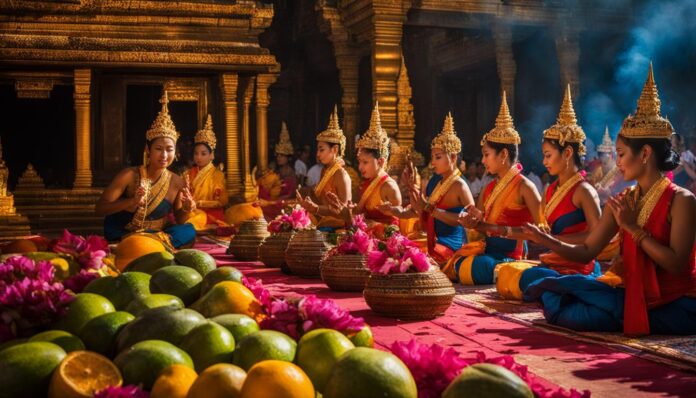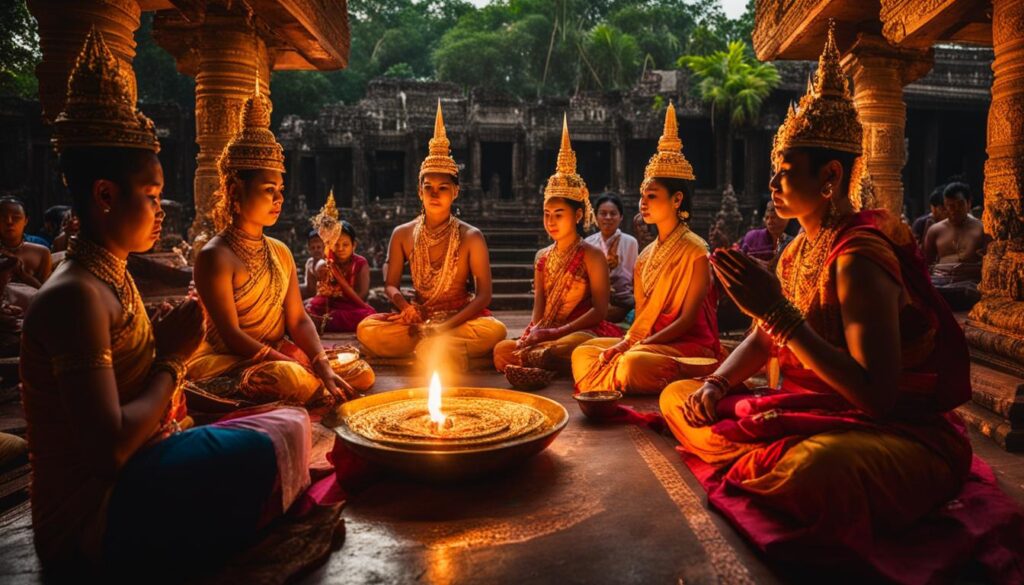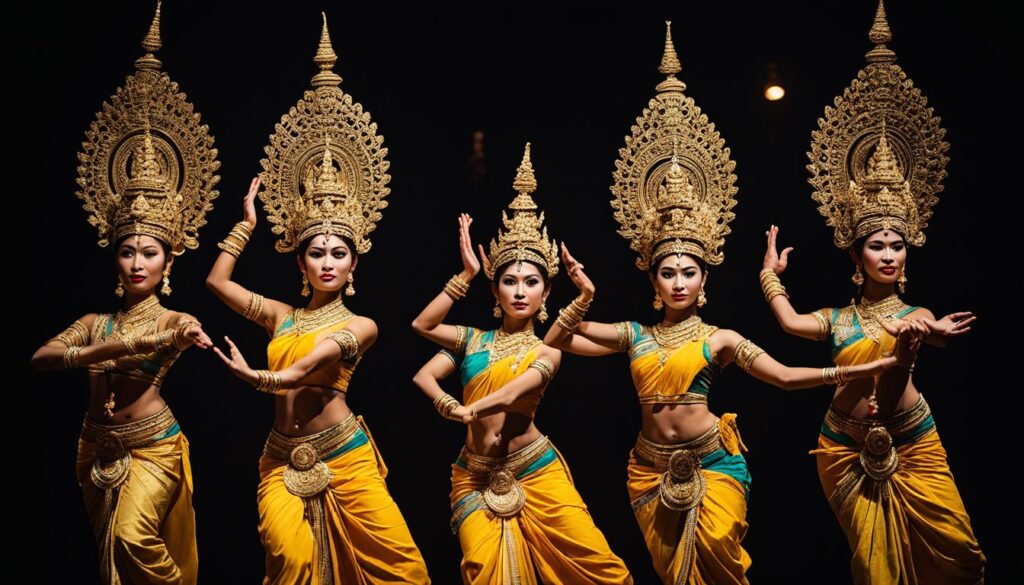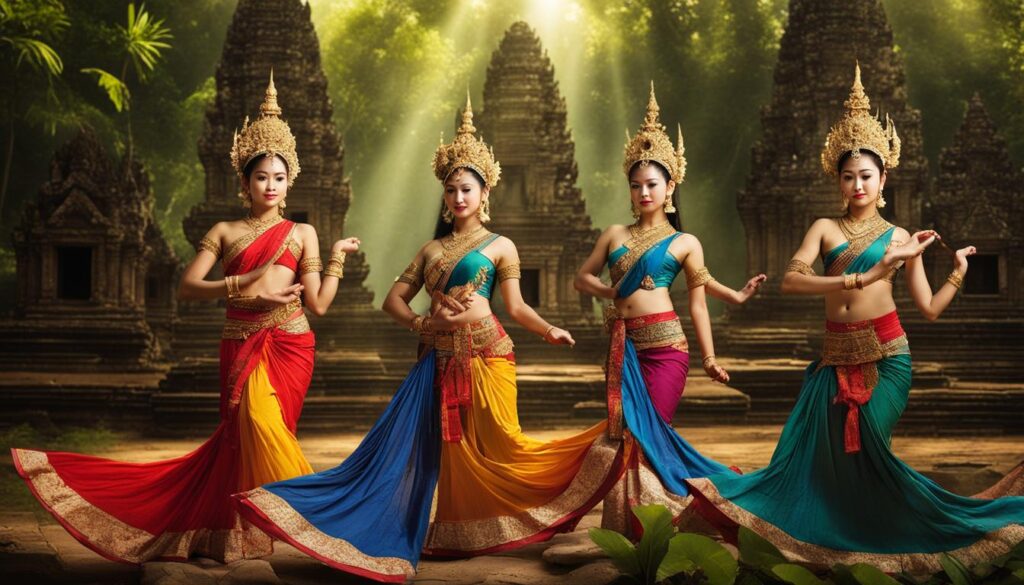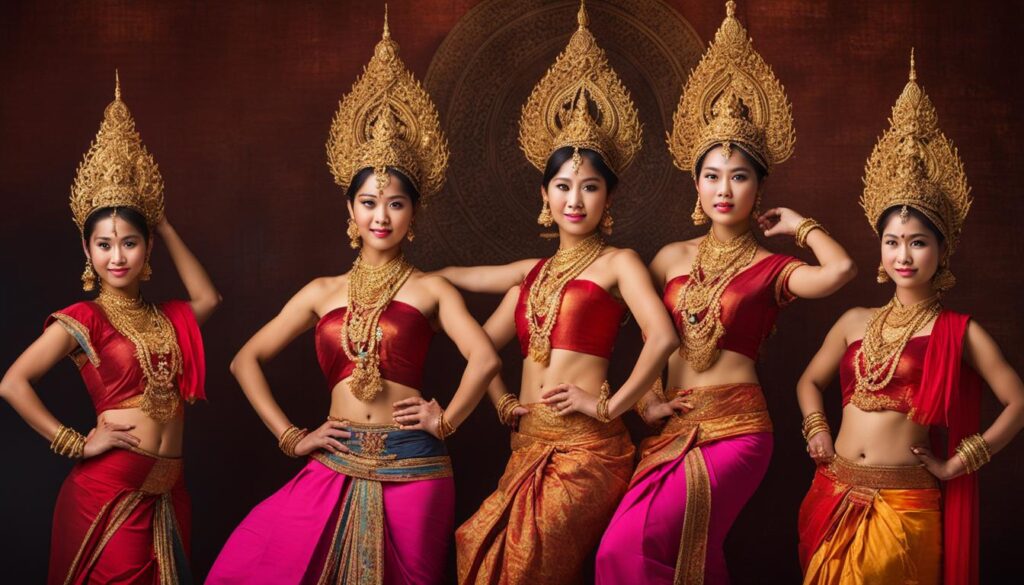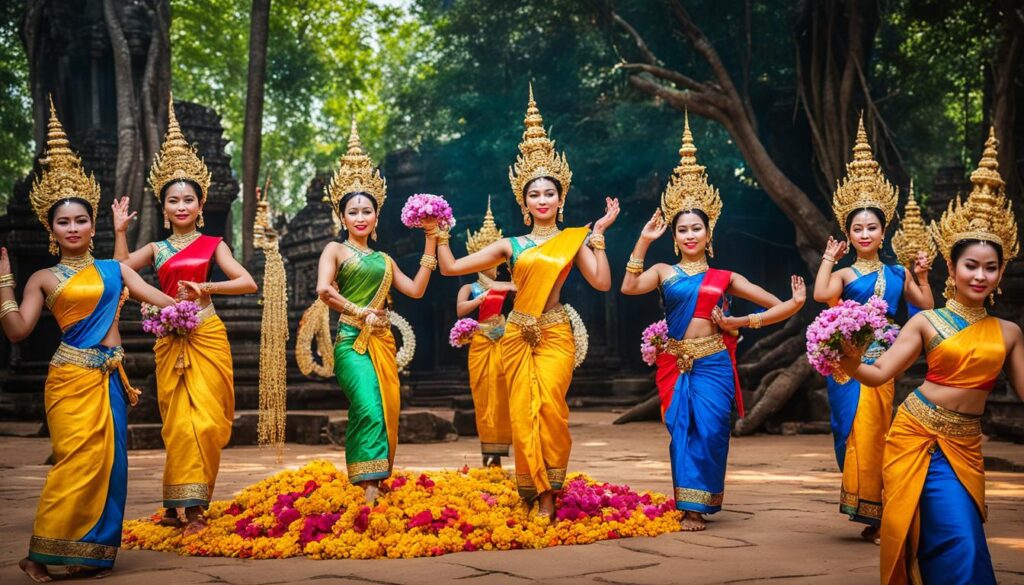Discover the enchanting cultural heritage of Siem Reap in Cambodia with traditional Khmer blessing ceremonies and mesmerizing Apsara dance performances. Siem Reap is a city that takes great pride in its deep-rooted Khmer culture, and visitors have the chance to immerse themselves in its traditions. From sacred blessings to breathtaking performances, Siem Reap is a must-visit destination for anyone seeking an authentic cultural experience.
Siem Reap: The Heart of Khmer Culture
Siem Reap, located in northwestern Cambodia, offers a diverse range of attractions that allow visitors to explore the heart of Khmer culture. Delve into the spectacular ancient temples, museums, and art galleries that celebrate the rich history and traditions of Cambodia. Experience the colorful and lively traditional ceremonies Siem Reap has to offer, such as the traditional Khmer blessing ceremonies and cultural performances.
Learn more about the cultural significance of these experiences and the Khmer culture as a whole, which is deeply rooted in spirituality, prosperity, and tradition.
“Siem Reap is a treasure trove of Khmer culture, waiting to be discovered and experienced.”
Traditional Khmer Blessing Ceremonies: A Sacred Experience
Siem Reap is a hub of cultural traditions, and Traditional Khmer Blessing Ceremonies are an essential part of Cambodian culture. These sacred ceremonies represent hope, faith, and goodwill for the people of Cambodia, and participating in them offers a unique and immersive cultural experience.
The ceremonies are performed by highly respected monks, who use their spiritual authority to transfer divine power to individuals or groups seeking peace, health, and prosperity. These ceremonies involve the use of chanting, which is believed to give blessings and create a harmonious balance between the individual and their surroundings. Witnessing the ceremonies is a humbling and spiritual experience that evokes a sense of tranquility in the participants.
Khmer culture is rich in spirituality, and Traditional Khmer Blessing Ceremonies are symbolic of the beliefs that underpin this way of life. In Siem Reap, you have the chance to learn about these spiritual practices and to engage with the local communities that uphold these beliefs.
Participating in Traditional Khmer Blessing Ceremonies presents a unique opportunity to connect with the spiritual and cultural traditions of Cambodia. Witnessing these sacred ceremonies is a once-in-a-lifetime experience that one should not miss while in Siem Reap.
Apsara Dance: Grace and Elegance Unleashed
Witness one of the most mesmerizing aspects of Khmer culture by experiencing an Apsara dance performance in Siem Reap. Apsara dance is a traditional Cambodian dance form that dates back hundreds of years and showcases the beauty and grace of Khmer cultural heritage.
The dance form is renowned for its intricate costumes and graceful movements, which evoke a sense of enchantment and wonder in those who witness the performances. The dancers wear traditional Khmer costumes, which are adorned with intricate golden designs, and their movements are characterized by fluid motions that depict stories from Khmer mythology.
“The beauty of Apsara dance lies not just in its entrancing movements, but also in the way it reflects the cultural history and mythology of Cambodian people.”
Siem Reap offers a range of Apsara dance performances for visitors to witness and immerse themselves in the richness of Khmer culture. Be sure not to miss a chance to witness this beautiful dance form during your visit.
Experience the rich culture of Khmer heritage through an Apsara dance performance in Siem Reap.
The Origins of Apsara Dance
The Apsara dance is an ancient Cambodian traditional dance that dates back to the Angkor period. This dance form is an integral part of Khmer culture and showcases the grace, beauty, and elegance of the Cambodian people. The term “Apsara” means “celestial nymphs,” and the dance is inspired by the movements of the celestial beings from Hindu mythology.
According to legend, the dance was first performed in 800 AD during the reign of King Jayavarman II. The dance was performed by celestial maidens who descended from the heavens to entertain the king and his people.
Over the centuries, the Apsara dance has evolved and changed to reflect the cultural and societal changes in Cambodia. During the Khmer Rouge regime, the dance was nearly lost, but efforts to revive and preserve the tradition have led to its resurgence in modern times.
“The Apsara dance is a cherished part of our cultural heritage. It embodies the grace and beauty of our people and serves as a fitting tribute to our ancestors.” — Khuon Sethisak, Cambodian cultural expert
Today, Apsara dance performances are a popular attraction for tourists visiting Siem Reap and other parts of Cambodia. The dance is often performed at cultural events, festivals, and important ceremonies. Despite its long and complex history, the beauty of the Apsara dance continues to captivate audiences around the world.
The Beauty of Apsara Dance Costumes and Movements
Experience the mesmerizing beauty of Apsara dance performances that showcase traditional Cambodian dance and Khmer costumes. The intricate hand gestures, delicate footwork, and graceful movements of the dancers transport you to a world of elegance and enchantment. But the beauty of Apsara dance goes beyond just the movements – the costumes also play an important role in telling the story of each dance.
The Khmer costumes worn by the dancers are designed to reflect the rich cultural heritage of Cambodia. The intricate patterns and mesmerizing colors are inspired by traditional paintings dating back hundreds of years, ensuring every performance is an authentic window into Khmer culture. From the intricacy of the headdresses to the billowing silks of the skirts, every element of the costumes has a symbolic meaning and represents the beauty and grace of the Khmer civilization.
As the dancers sweep across the stage in harmony with traditional Khmer music, every gesture and movement tells a different story. From the elegant hand movements that symbolize the grace of apsaras (celestial nymphs) to the intricate footwork that represents the movements of the birds, Apsara dance is a story told through movement.
If you have ever wondered about the beauty and complexity of Apsara dance costumes and movements, a visit to Siem Reap is a must.
Where to Experience Khmer Blessings and Apsara Dance in Siem Reap
Siem Reap is the perfect destination to witness traditional Khmer blessing ceremonies and Apsara dance performances in Cambodia. Whether you are looking for a cultural experience or seeking to explore the rich history and traditions of Khmer culture, there are various options to choose from for an authentic and unforgettable experience.
One great place to experience Khmer blessing ceremonies is at the grand Angkor Wat temple complex, where you can witness monks performing sacred rituals at sunrise or sunset. Alternatively, head to Wat Bo Pagoda, where you can partake in a traditional blessing ceremony with water and flowers.
For a mesmerizing Apsara dance performance, visit the Angkor Village Apsara Theatre or the Rosana Broadway Theatre, where you can enjoy stunning performances accompanied by live traditional Khmer music.
If you are looking for a more luxurious experience, the Belmond La Residence d’Angkor offers a traditional Khmer blessing ceremony followed by a private Apsara dance performance.
Wherever you choose to go in Siem Reap, these cultural experiences will leave you with unforgettable memories of Khmer culture and its rich traditions.
Planning Your Cultural Journey in Siem Reap
Make sure you plan your cultural journey in Siem Reap efficiently to fully immerse yourself in the rich Khmer culture and traditions. The best time to visit is between November and March when the weather is cool and dry, and there are plenty of cultural performances and festivals to attend.
For an authentic experience, consider staying in a traditional Khmer-style hotel like Belmond La Résidence d’Angkor or Shinta Mani Shack that offer Khmer cuisine and cultural activities.
There are countless Siem Reap attractions to explore: apart from witnessing traditional ceremonies like the Chol Preah Khan Reach and Preah Reach Trop, immerse yourself in Apsara dance performances at local venues like Phare, the Cambodian Circus or Smile of Angkor.
Don’t forget to check out other cultural performances such as puppet shows and shadow plays, and visit the local night markets to find handcrafted souvenirs that reflect Khmer culture.
“Siem Reap offers a gateway into the captivating world of traditional Khmer blessing ceremonies and mesmerizing Apsara dance performances.”
Beyond Apsara Dance: Exploring Siem Reap’s Cultural Tapestry
Siem Reap offers a vibrant and diverse cultural landscape that goes beyond the mesmerizing Apsara dance performances and traditional Khmer blessing ceremonies. To fully immerse yourself in the richness of Khmer culture, it’s worth exploring other ceremonies, art forms, and cultural performances that showcase the city’s unique tapestry of traditions and customs.
Traditional Ceremonies
Siem Reap is home to a plethora of traditional ceremonies that offer a window into the city’s cultural fabric. One such ceremony is the water blessing ceremony, where locals gather near the river to celebrate the beginning of the rainy season while seeking blessings for their crops and homestead. Another fascinating ceremony is the coconut dancing ceremony, where performers dance while balancing towering stacks of coconuts on their heads – a testament to the strength and agility of the human body. These impressive performances highlight the ingenuity and creativity of the Khmer people and offer a unique cultural experience.
Khmer Art Forms and Performances
In addition to traditional ceremonies, Siem Reap is also known for its vibrant arts and cultural performances. Whether it’s visiting a local art gallery to explore contemporary Khmer art or watching a shadow puppet show, there’s something for every art enthusiast in Siem Reap. Don’t miss the Phare Ponleu Selpak Circus, where performers showcase a range of acrobatic stunts and art forms that reflect the resilience and creativity of the Khmer people. These performances offer a unique blend of entertainment and cultural education, providing a comprehensive insight into the city’s cultural landscape.
Siem Reap Attractions
Aside from its cultural offerings, Siem Reap is also home to a wide range of other attractions. From exploring the ancient temples of Angkor to strolling through the vibrant night markets, Siem Reap offers a wealth of experiences that showcase the city’s diverse character. Don’t miss the chance to explore the Cambodian Landmine Museum, which offers insights into the country’s challenging history with landmines, or visit the artisan workshops to learn about traditional Khmer handicrafts.
Exploring Siem Reap’s cultural tapestry is an unforgettable experience that offers a comprehensive insight into the city’s customs, traditions, and way of life. Don’t miss the chance to create timeless memories and gain a deeper appreciation of the richness and diversity of Khmer culture.
Enhancing Your Siem Reap Experience: Engaging with the Community
Siem Reap isn’t just a place to sightsee, it’s a chance to get to know the vibrant Khmer culture. Engage with the local community and take part in workshops to learn more about traditional ceremonies and cultural performances.
Visit local artisans and support community initiatives that aim to preserve and promote Khmer traditions. This will not only give you a better understanding of the culture, but it’s also an opportunity to give back to the local community.
Interact with the locals and listen to their stories; it’s one of the best ways to immerse yourself further into the Siem Reap experience.
Support Local Communities
Make your trip more meaningful by supporting local communities who strive to preserve and promote Khmer traditions. One such initiative is the Artisans Angkor, a social business that provides artisans with vocational training and employment. Buying souvenirs from such organizations will help support the local communities.
| Kinds of Souvenirs | Description |
|---|---|
| Silk scarves | Beautifully hand-woven using traditional techniques. |
| Wood Sculptures | Hand-made from sustainable materials, each piece is unique. |
| Silver Jewelry | Exquisitely designed and crafted by skilled artisans. |
These unique souvenirs will not only remind you of your trip to Siem Reap, but they’ll also serve as a reminder of the importance of preserving cultural traditions.
“There’s no better way to learn about Khmer culture and traditions than by interacting with the locals. Engage with the community and take part in workshops to learn more about the beautiful ceremonies and performances that are part of the cultural tapestry of Siem Reap.”
As you explore Siem Reap, make every effort to engage with the local community and learn about their traditions. The memories and experiences you take home will be more meaningful and memorable than any souvenir could ever be.
Unforgettable Memories: Bringing Siem Reap’s Culture Home
As you prepare to leave Siem Reap, you can take a piece of Khmer culture with you through handmade crafts, traditional clothing, and other unique souvenirs that reflect the vibrant spirit of this enchanting city.
Siem Reap offers a wide range of options for souvenirs such as intricate carvings made of wood or stone, paintings, silk scarves with traditional Khmer motifs, and silver jewelry. You can also visit local markets where you will find locally-made products, or directly purchase from artisans for a more authentic experience.
Handicrafts
Take home a piece of local handicrafts such as carvings made of wood or stone. With intricate designs and unique motifs used, these handicrafts are a perfect addition to your home decor. You can easily find handicrafts shops along street vendors, night markets, and souvenir shops.
Traditional Clothing
For those who appreciate traditional clothing, Siem Reap offers a range of traditional Khmer clothing such as scarves, skirts, shirts, and pants. You will find these clothing items in local markets, souvenir shops, and boutique stores. The clothing is made from high-quality silk and cotton, with beautiful patterns that reflect Khmer culture.
Other Unique Souvenirs
Experience the local culture by purchasing locally-made products such as silver jewelry, bamboo baskets, and colorful paintings. These souvenirs reflect the true essence of Siem Reap and allow you to take home a piece of the city with you.
Conclusion
Siem Reap is a treasure trove of Khmer culture, offering visitors a chance to witness traditional Khmer blessing ceremonies and fascinating Apsara dance performances. By immersing yourself in these captivating cultural experiences, you can discover the rich heritage of Cambodia and create unforgettable memories in this enchanting city.
Whether you’re exploring Siem Reap’s ancient temples or discovering the intricacies of Khmer art forms, you’ll find yourself in awe of the vibrant cultural scene. Don’t miss out on the chance to engage with local communities, support traditional artisans, and preserve the precious traditions that make Siem Reap so special.
From the beauty of Apsara dance performances to the sacred nature of traditional Khmer blessing ceremonies, Siem Reap invites you to embrace the essence of Khmer culture. So pack your bags, book your trip, and get ready to immerse yourself in the heart and soul of this enchanting city.
Keywords: Traditional Khmer blessing ceremonies, Apsara dance performances, Siem Reap, Khmer culture




























